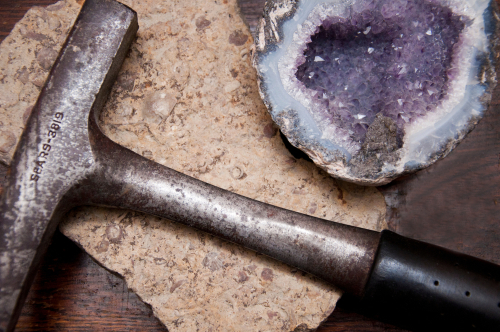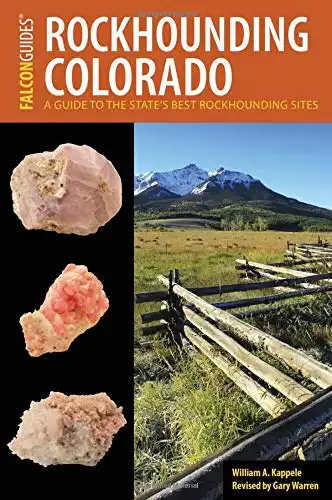Remember! It is your responsibility to know the rockhounding laws and regulations for each site you visit. It is also your responsibility to verify and gain permission to visit each collection site that is mentioned on this website. Always respect private property!
Despite the rich abundance of rocks, minerals and gemstones across the entire state of Colorado, many of the best rockhounding locations are understandably kept hush hush.
And those that aren’t kept so secret are often times in areas that are under private claim. However, when it comes to knowing where to go to find geodes in Colorado, you’ve come to the right place!
In this article, I’m going to share with you some of the best places to hunt for geodes in Colorado. And although these might not be secret locations, they’re well worth taking the time to visit and check out yourself.
Where To Find Geodes In Colorado

1. Wolf Creek Pass
Wolf Creek Pass is a series of rock cliffs right alongside highway 160 in Colorado. That makes it a little dangerous for kids and pets to rockhound in the area, but it’s a great spot for responsible adults to find nodules and geodes filled with crystals.
The most common nodules and geodes are about 5 inches in diameter, and they typically contain amethyst, agate, quartz, and white natrolite. The pass is about 8 miles long. So, there’s plenty of room for you to move around and search for the newest addition to your collection.
One thing to keep in mind about Wolf Creek Pass is that the ground is pretty hard, and the cliffs are even harder. You’ll need some heavy-duty rockhounding tools to properly dig there. However, you don’t need a permit, and you’re free to take your finds home with you. Just make sure to stay out of the way of oncoming traffic while you’re digging, and if you dig on the cliffs, don’t let anything go flying into the road!
2. Whitewater
Whitewater is a little dig site in Grand Junction, about 3.4 miles east of 1st Street in the town of Whitewater. Recent agricultural developments have made it a little tricky to get to the actual digging area, but you want to follow the highway east of 1st Street, and you want to look for a gate on the left side of the road.
You’ll have to turn around a short way up the highway to legally turn into the gate, but there’s a small parking area available once you get in. From there, you want to walk up the only visible hill near the parking area, and on you’re right you’ll see a gully. Once you’ve reached the gully, you can strap yourself in for a day of fruitful digging!
The best part of the gully to dig in is about halfway up the southern slope. You’ll see a bunch of holes from past diggers the second you reach it. You’ll be able to find quartz geodes fairly easily, but you’ll also find marine fossils from when Colorado was a seabed.
Some of the larger fossils can net you an impressive wad of cash, but they’re mostly small shellfish and fragments of larger sea animals.
The ground is a lot softer at Whitewater compared to other dig sites. So, you won’t have to bring heavy-duty tools with you. Basic rockhounding equipment will work just fine.
However, you will want to keep your vehicle in the parking area. Driving to the dig site is possible, but the ground is so soft that you might end up getting stuck there.
Finally, Whitewater is completely open to the public, and there aren’t any major safety concerns. So, this is a great spot to bring your teenage rockhounds or your pet, and it’s a decent place to help you start your collection.
3. Felch Creek
Felch Creek is another public area that has a small variety of crystals and minerals. The actual dig site is a series of bluffs near Fourmile Creek and County Road 9, and that’s the only site in the area that I recommend visiting.
When you go, you’ll likely find geodes containing different kinds of quartz, and you can find jasper and agate there, too. That’s not a huge variety, and none of those are particularly valuable, but they’re so common that you can easily add three new stones to your collection, or you can kickstart a budding collection without worrying about getting skunked.
The ground is soft enough that you can use basic tools for all your digging, and the area is mostly safe. Some parts of the bluffs have sheer drops, but you can avoid those areas and still have a great day of digging.
4. Houselog Creek
Houselog Creek is a good spot to visit if you want to load up on jasper and agate geodes. The minerals themselves can be found outside of geodes as well. So, keep your eyes open.
You won’t find much of anything else there, but the jasper is usually white in color, and the agate comes in a wide range of colors from yellow-green to deep red. You can easily find the entire color range within a day or two of digging at Houselog Creek, and I suggest using the area for that reason. When it comes time to flesh out your agate collection, you won’t have to visit multiple locations to get a wide range of specimens.
If you decide to take a look at this location, it’s west of Sagauche, and there are plenty of signs to direct you to it once you’re on the highway.
5. Garden Park
Garden Park is a large dinosaur quarry outside of Canon City, Colorado, and it’s open to the public. You can find geodes at the quarry, but the biggest draws are the dinosaur fossils. The quarry contains fossils of Jurassic-period flora, crocodiles, dinosaur footprints, and even dinosaur bones. Many of the fossils excavated from the area have found homes in museums around the world.
The quarry is free for you to enter, and you can take your finds home with you, or you can try to sell them to a museum if they’re particularly rare. However, there are guide services available that will help you have a productive day of digging, and the surrounding area is developed to provide hiking, mountain biking, and exploration experiences. There’s even a museum and gift shop that will allow you view or buy fossils that have already been excavated.
If you want to take a closer look at Garden Park, you can click this link.
You Might Also Be Interested In…
Rockhounding Colorado takes you to 100 of the best rockhounding sites in the state. Search for amethyst and quartz at the Crystal Hill Mine, check out the view at Douglas Pass while looking for leaf imprints and insect fossils, or head to Saint Peters Dome to uncover green, white, and purple fluorite.
- Online rock and mineral club for collectors of all levels!
- Find community with like-minded rock and mineral enthusiasts.
- Monthly Giveaways!
- Free Access to Entire Digital Library of Products (current and future products)*



